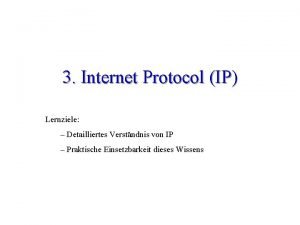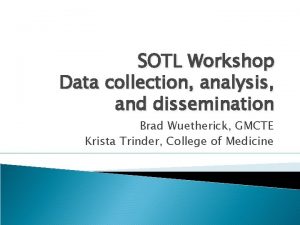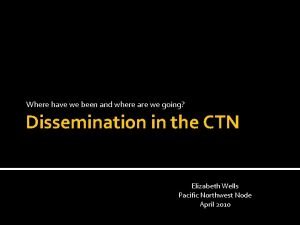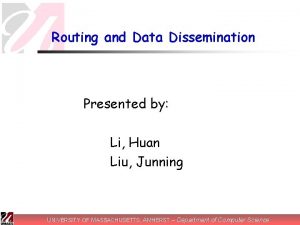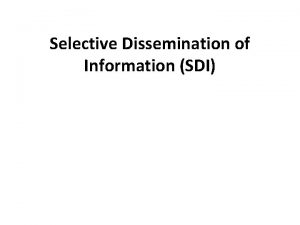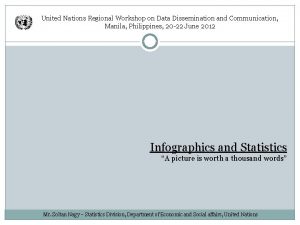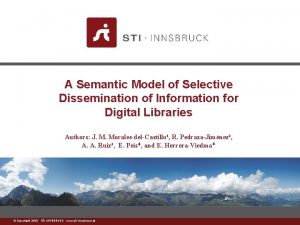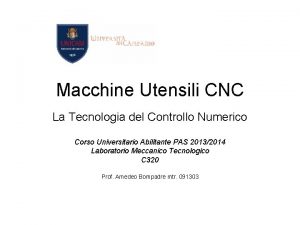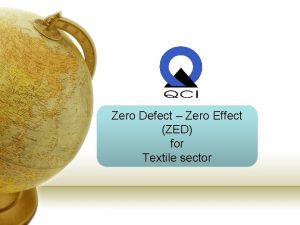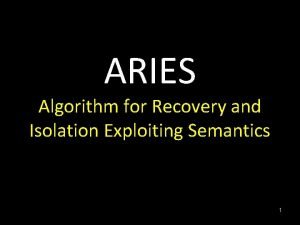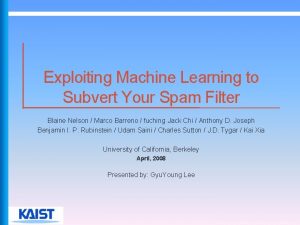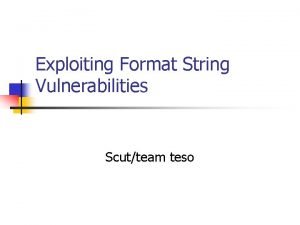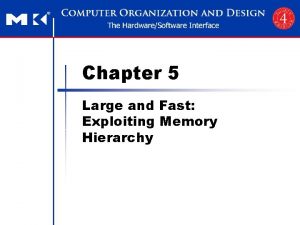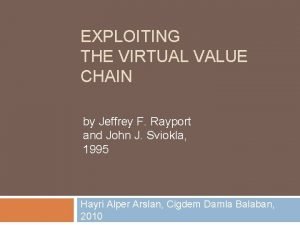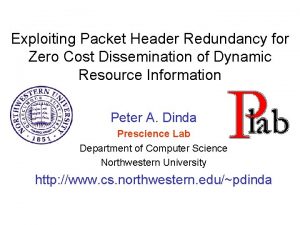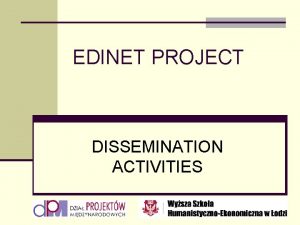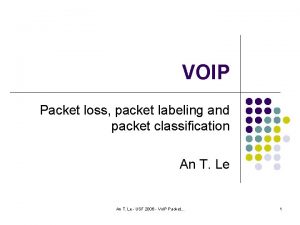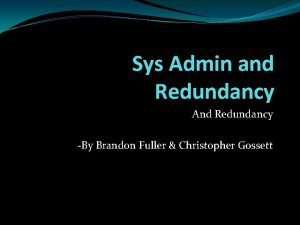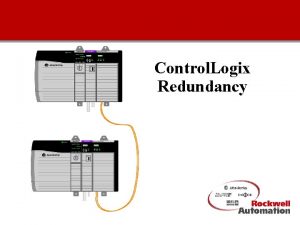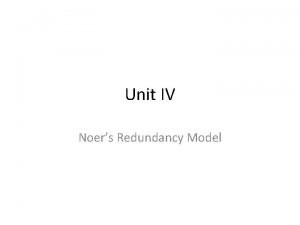Exploiting Packet Header Redundancy for Zero Cost Dissemination























- Slides: 23

Exploiting Packet Header Redundancy for Zero Cost Dissemination of Dynamic Resource Information Peter A. Dinda Prescience Lab Department of Computer Science Northwestern University http: //www. cs. northwestern. edu/~pdinda

Overview • Piggyback information on outgoing packets • Encode information into redundant or unused TCP, IP, and Ethernet fields • Result: Disseminate information with no additional packets or increased packet size • Identified: >=86 bits per packet • Proof-of-concept: 17 bits per packet 2

Outline • • Disseminating dynamic resource info Theoretical redundancy Mechanisms for exploiting redundancy Prospects Proof-of-concept Using the mechanisms Conclusion and future work 3

Disseminating Dynamic Resource Information Sensor Consumer 4

Current Model Sensor App Transport Network Data Link Physical App Consumer Transport Network Data Link Physical Sensor is just another application 5

Problems With Current Model • Bandwidth consumption – Can be reduced via adaptive techniques – Different available BW to different consumers • Additional packets injected into network • Consumers must know to ask for data But packets already flow through the network! 6

Proposed Model Sensor App Transport Network Header Editing Data Extraction Data Link Physical Consumer Sensor data piggybacked on application packets 7

Header Editing Sensor Data Ethernet IP TCP Data Padding Overwrite unused or redundant fields with sensor data How much redundancy is there and how do we exploit it? 8

Packet Traces • NLANR Passive Measurement Network • All packets at points of presence • 28 90 second traces – 4 sites (U. Buffalo, Columbia, Colorado State, U. Memphis) – Late September, 2001 – 68, 000 to 3 million packets per trace 9

How Much Redundancy Is There? • Headers as a sequence of 1 byte symbols • Shannon entropy – Number of bits needed per symbol – Does not capture correlation • Mutual information – Bits per byte assuming one-step correlations Evaluate theoretical limits to redundancy 10

Redundancy in IP Headers • Shannon entropy: 4. 8 bits per byte – 40 % redundant – 8 extra bytes per header • Mutual information: 1. 2 bits per byte – 85 % redundant – 17 extra bytes per header Considerable redundancy is available How does this redundancy manifest in practical ways? 11

Practical Mechanisms: TCP Header source port destination port sequence number acknowledgement number hlen reserved flags window size checksum urgent pointer options Mechanism Bits Reserved bits 6 Ack field when ACK=0 32 Urgent field when URG=0 16 NOP option padding varies Total >=54 12

Prospects: TCP Header source port destination port sequence number acknowledgement number hlen reserved flags window size checksum urgent pointer options Mechanism Bits Reserved bits 6 NOP option padding Always Zero! 32 Untested 16 Untested varies Options rare Total >=54 Ack field when ACK=0 Urgent field when URG=0 13

Practical Mechanisms: IP Header vers hlen TOS length flags fragment offset identifier TTL protocol checksum source address destination address options Mechanism Bits Reserved TOS bits 2 Reserved IP flag 1 Identifier when DF=1 16 Fragment offset when DF=1 13 NOP option padding varies Total >=32 14

Prospects: IP Header vers hlen TOS length flags fragment offset identifier TTL protocol checksum source address destination address options Mechanism Bits Reserved TOS bits 2 NOP option padding 95% Zero 1 Always zero 16 90% DF=1 13 varies Options rare Total >=32 Reserved IP flag Identifier when DF=1 Fragment offset when DF=1 15

Practical Mechanisms: Ethernet Padding Ethernet IP TCP Data Padding Ethernet frame’s data must be at least 46 bytes long TCP+IP+keystroke = 20+20+1 = 41 bytes TCP ACK = 20+20 = 40 bytes Prospects: Untested 16

Proof-of-concept • Evaluate IP Header approaches • Random bit source for data • Minet user-level stack – ~20 lines of header-editing/data extraction code – ~200 lines of ancillary code (output) • Study interaction with Linux stack (2. 2 kernel) and Cisco router 17

Proof-of-concept results Bits Minet to Linux Minet to Router to Linux Demonstrated bits Reserved TOS bits 2 OK FAILS OK 0 Reserved IP flag 1 OK OK OK 1 Identifier when DF=1 16 OK OK OK 16 Fragment offset when DF=1 13 FAILS 0 NOP option padding varies untested 0 Total >=32 Mechanism 17 IP Header can transport 17 extra bits 90% of the time What should we use them for? 18

Using the Bits • 1 sample per packet – Host load: 1. 4 -15 bits per sample – Network bandwidth / latency: ? – Sample resolution can be varied • Timestamps – Easy for TCP packets – use RTT estimate 19

Using the Bits • Using this channel to transport streams • Unreliable like IP • Also can’t choose where/when data is sent – Only goes to “friendly” hosts – Or have to wait until someone sends a packet to the machine you are targeting • What are appropriate coding approaches? 20

Diffusion Sensor Random Drop Header Editing App Transport Network Consumer Data Extraction Data Link Physical Information diffuses out from a sensor to “friendly” hosts 21

Conclusions and Future Work • Introduced concept of exploiting packet header redundancy for zero cost information dissemination – Intentionally extreme approach • Identified mechanisms and prospects • Demonstrated proof-of-concept • Future work: Linux kernel implementation 22

For More Information • Peter Dinda – http: //www. cs. northwestern. edu/~pdinda • Minet – http: //www. cs. northwestern. edu/~pdinda/minet/ • Prescience Lab – http: //www. cs. northwestern. edu/~plab 23
 Ip header vs tcp header
Ip header vs tcp header Dissemination
Dissemination Collection analysis dissemination of data
Collection analysis dissemination of data Challenges of information dissemination
Challenges of information dissemination Data dissemination
Data dissemination Dissemination plan
Dissemination plan Ctn dissemination library
Ctn dissemination library Dissemination
Dissemination Dissemination
Dissemination Importance of selective dissemination of information
Importance of selective dissemination of information Dissemination
Dissemination Data dissemination diagram
Data dissemination diagram Components of selective dissemination of information
Components of selective dissemination of information Unità di governo cnc
Unità di governo cnc Zero defect zero effect
Zero defect zero effect Algorithm for recovery and isolation exploiting semantics
Algorithm for recovery and isolation exploiting semantics Define new entry in entrepreneurship
Define new entry in entrepreneurship Spamato
Spamato Exploiting format string vulnerabilities
Exploiting format string vulnerabilities What is a sport/event entity?
What is a sport/event entity? Large and fast: exploiting memory hierarchy
Large and fast: exploiting memory hierarchy Physical value chain
Physical value chain Zero cost collar
Zero cost collar Zero cost collar
Zero cost collar
